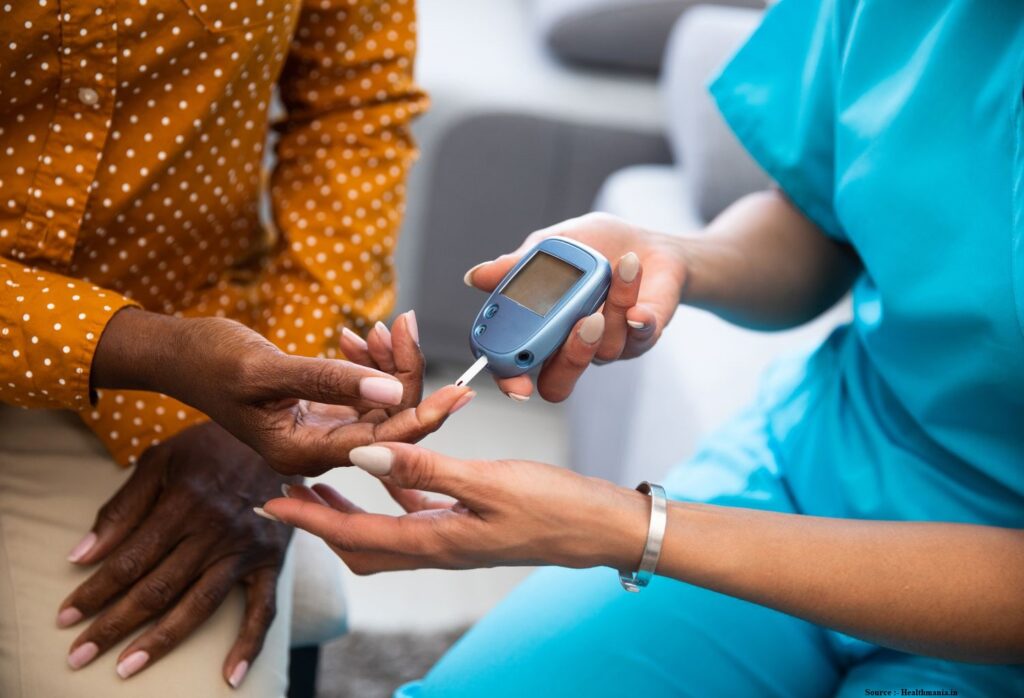
Diabetes is a chronic, metabolic disease characterized by elevated levels of blood glucose (or blood sugar), which leads over time to serious damage to the heart, blood vessels, eyes, kidneys and nerves. The most common is type 2 diabetes, usually in adults, which occurs when the body becomes resistant to insulin or doesn’t make enough insulin. In the past 3 decades the prevalence of type 2 diabetes has risen dramatically in countries of all income levels. Type 1 diabetes, once known as juvenile diabetes or insulin-dependent diabetes, is a chronic condition in which the pancreas produces little or no insulin by itself. For people living with diabetes, access to affordable treatment, including insulin, is critical to their survival. There is a globally agreed target to halt the rise in diabetes and obesity by 2025.
About 422 million people worldwide have diabetes, the majority living in low-and middle-income countries, and 1.5 million deaths are directly attributed to diabetes each year. Both the number of cases and the prevalence of diabetes have been steadily increasing over the past few decades.
What is diabetes?
Diabetes is a condition that happens when your blood sugar (glucose) is too high. It develops when your pancreas doesn’t make enough insulin or any at all, or when your body isn’t responding to the effects of insulin properly. Diabetes affects people of all ages. Most forms of diabetes are chronic (lifelong), and all forms are manageable with medications and/or lifestyle changes.
Glucose (sugar) mainly comes from carbohydrates in your food and drinks. It’s your body’s go-to source of energy. Your blood carries glucose to all your body’s cells to use for energy.
When glucose is in your bloodstream, it needs help — a “key” — to reach its final destination. This key is insulin (a hormone). If your pancreas isn’t making enough insulin or your body isn’t using it properly, glucose builds up in your bloodstream, causing high blood sugar (hyperglycemia).
Over time, having consistently high blood glucose can cause health problems, such as heart disease, nerve damage and eye issues.
The technical name for diabetes is diabetes mellitus. Another condition shares the term “diabetes” — diabetes insipidus — but they’re distinct. They share the name “diabetes” because they both cause increased thirst and frequent urination. Diabetes insipidus is much rarer than diabetes mellitus.
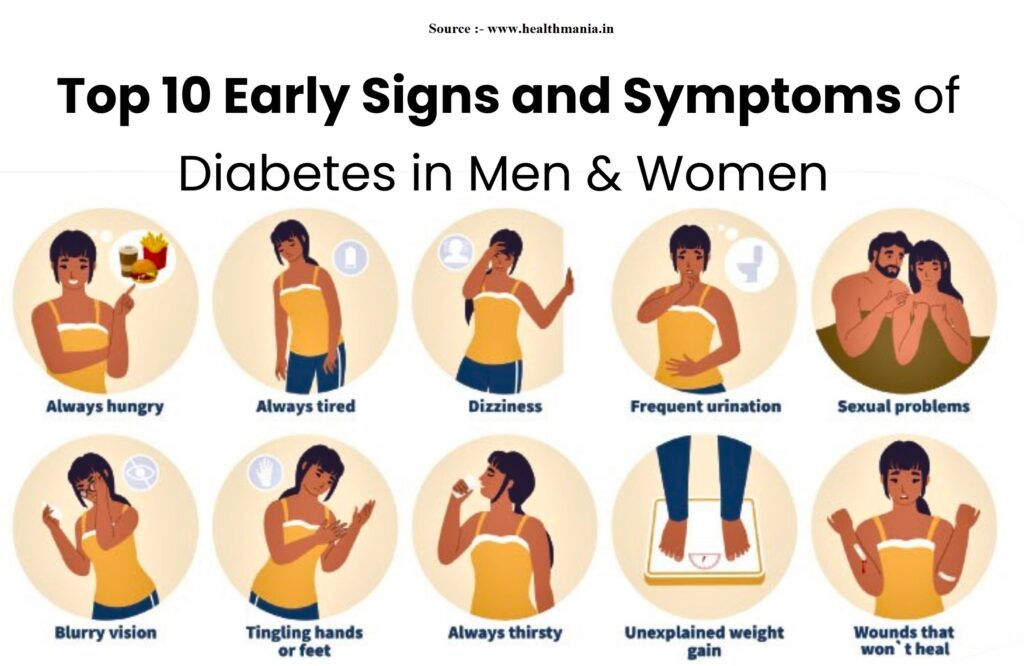
Symptoms
Diabetes symptoms depend on how high your blood sugar is. Some people, especially if they have prediabetes, gestational diabetes or type 2 diabetes, may not have symptoms. In type 1 diabetes, symptoms tend to come on quickly and be more severe.
Some of the symptoms of type 1 diabetes and type 2 diabetes are:
Feeling more thirsty than usual.
Urinating often.
Losing weight without trying.
Presence of ketones in the urine. Ketones are a byproduct of the breakdown of muscle and fat that happens when there’s not enough available insulin.
Feeling tired and weak.
Feeling irritable or having other mood changes.
Having blurry vision.
Having slow-healing sores.
Getting a lot of infections, such as gum, skin and vaginal infections.
Types of diabetes
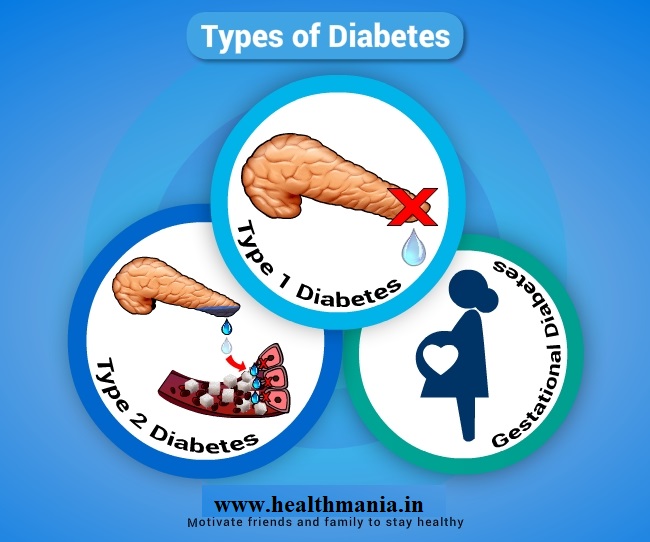
Certainly! There are three main types of diabetes:
Type 1 Diabetes:
Believed to be an autoimmune condition.
The immune system mistakenly attacks and destroys the beta cells in the pancreas that produce insulin.
The damage is permanent, and the exact cause is not entirely clear.
Genetic and environmental factors may play a role.
Lifestyle factors are not believed to be significant contributors.
Type 2 Diabetes:
Starts as insulin resistance.
The body cannot use insulin efficiently, leading to increased insulin production by the pancreas.
Over time, insulin production decreases, causing high blood sugar levels.
The exact cause of type 2 diabetes remains unknown.
Contributing factors include genetics, sedentary lifestyle, and higher weight or obesity.
Gestational Diabetes:
Occurs during pregnancy due to insulin-blocking hormones.
Typically seen in people with preexisting prediabetes and a family history of diabetes.
About 50% of those diagnosed with gestational diabetes later develop type 2 diabetes1.
Common symptoms of unmanaged diabetes include excessive thirst, frequent urination, drowsiness, dry skin, blurry vision, and slow-healing wounds. Type 2 diabetes can also cause discolored patches in the folds of skin in the armpits and neck.
Remember that symptoms can appear at any age, but type 1 diabetes usually develops in children and young adults, while type 2 typically appears in people over the age of 45. However, younger individuals are increasingly being diagnosed with type 2 diabetes due to sedentary lifestyles and weight gain1.
In the United States, approximately 37.3 million people have diabetes, with 5-10% having type 1 and 90-95% having type 2 diabetes1. If you have any specific questions or need further information, feel free to ask!
What to eat and avoid while on a ‘diabetes diet’
A diet rich in vegetables, fruits, and lean proteins can benefit a person with diabetes. At the same time, a person with diabetes may need to limit their intake of white bread, sweets, and other highly refined foods.
Both sugary and starchy carbohydrates can raise blood sugar. But these foods, in the right amounts, can play a role in a balanced meal plan. The right amount and type of carbohydrates can depend on many factors, including a person’s activity level and medications, such as insulin.
This article looks at some of the best foods for people with diabetes, which foods to limit, and how to ensure a balanced diet.
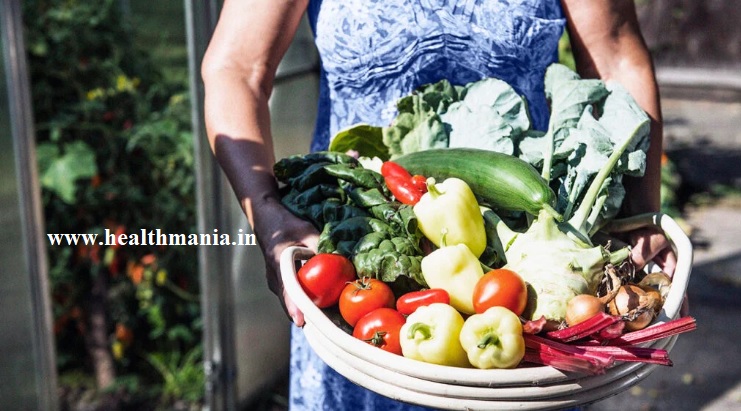
Green, leafy vegetables are a key plant-based source of potassium, vitamin A, and calcium. They also provide protein and fiber.
Some researchers Trusted Source have found that eating green, leafy vegetables can benefit people with diabetes due to these plants’ high antioxidant and fiber content.
Green, leafy vegetables include:
spinach
collard greens
kale
cabbage
bok choy
broccoli
Whole grains contain high levels of fiber and more nutrients than refined white grains.
Eating a diet high in fiber is important for people with diabetes because fiber slows the digestion process. Slower absorption of nutrients helps keep blood sugar stable.
Whole wheat and whole grains are lower on the glycemic index (GI) scale than white breads and rice. This means that they have less of an effect on blood sugar.
Good examples of whole grains to include in the diet are:
brown rice
whole grain bread
whole grain pasta
buckwheat
quinoa
millet
bulgur
rye
Fatty fish
Fatty fish is a beneficial addition to any diet. It contains important omega-3 fatty acids called eicosapentaenoic acid and docosahexaenoic acid. These are sometimes known as EPA and DHA.
People need certain amounts of healthy fats to keep their body functioning and to promote heart and brain health.
The American Diabetes Association (ADA) reports that a Mediterranean diet, a dietary plan high in polyunsaturated and monounsaturated fats may improve blood sugar management and blood lipids in people with diabetes.
Certain fish are a rich source of both polyunsaturated and monounsaturated fats. These are:
salmon
mackerel
sardines
albacore tuna
herring
trout
People can eat seaweeds, such as kelp and spirulina, as plant-based alternative sources of these fatty acids.
Beans
Beans are an excellent option for people with diabetes. They are a source of plant-based protein and can help satisfy the appetite while helping promote digestive health due to their high content of soluble fibers.
Beans are also low on the GI scale, which means they may be more effective for blood sugar management than many other starchy foods.
Among the many types of beans are:
kidney
pinto
black
navy
adzuki
Beans also containTrusted Source important nutrients, including iron, potassium, and magnesium.
Walnuts
Nuts can be another excellent addition to the diet. As with fish, nuts contain fatty acids that help keep the heart healthy.
Walnuts are especially rich in a type of omega-3 called alpha-linolenic acid (ALA). As with other omega-3s, ALA is important for heart health. People with diabetes may have a higher risk of heart disease or stroke, so it is important to consume these fatty acids.
A study from 2021Trusted Source suggested that eating walnuts has links with a lower incidence of diabetes.
Walnuts also provide key nutrients, such as protein, vitamin B6, magnesium, and iron.
Learn about other beneficial nuts for diabetes.
Citrus fruits
Eating these fruits can be an easy way to get vitamins and minerals. The ADA notes that citrus fruits, such as oranges, grapefruits, and lemons, can benefit people with diabetes.
Some researchers have found that citrus fruits are rich in many flavonoid antioxidants, such as hesperidin and naringin, which may exhibit antidiabetic effects.
Citrus fruits are also a great source of:
vitamin C
folate
potassium
Learn about other beneficial fruits for diabetes.
Berries
Berries are full of antioxidants, which can help prevent oxidative stress. Oxidative stress has links with a wide range of health conditions, including heart disease and some cancers.
Studies have found that oxidative stress contributes to type 2 diabetes. This occurs when there is an imbalance between antioxidants and unstable molecules called free radicals in the body.
Blueberries, blackberries, strawberries, and raspberries all contain antioxidants and fiber. They also contain important other vitamins and minerals, including:
vitamin C
vitamin K
manganese
potassium
Sweet potatoes
Sweet potatoes rank lower on the GI scale than white potatoes. This makes them a great alternative for people with diabetes, as they release sugar more slowly and do not raise blood sugar as much. They are also a good source of fiber, which also helps with blood sugar regulation.
Sweet potatoes are also a great source of:
vitamin A
vitamin C
potassium
Probiotic yogurt
Probiotics are the helpful bacteria that live in the human gut and improve digestion and overall health.
A small 2022 study Trusted Source found that people with type 2 diabetes and obesity who took probiotics supplements for 90 days had better blood sugar levels, higher levels of “good” cholesterol (also called HDL cholesterol), and healthier gut bacteria.
Another 2020 meta-analysis Trusted Source of 15 clinical trials found that probiotics may reduce insulin resistance, fasting blood sugar, and HbA1c (a measure of blood sugar management over a 3–4-month period) in people with diabetes.
A person should consider choosing a plain variety with no added sugar. Probiotic yogurt contains live, active cultures such as Lactobacillus and Bifidobacterium, which it may advertise on the label.
Chia seeds
People often call chia seeds a superfood because of their high antioxidant and omega-3 content. They are also a good source of plant-based protein and fiber.
In one small-scale trial from 2017, people who had overweight and type 2 diabetes lost more weight after 6 months when they included chia seeds in their diets compared with those who ate an oat bran alternative. The researchers support the beneficial role of chia seeds helping people with type 2 diabetes to manage their weight more effectively.
Obesity is a significant risk factor for diabetes, and weight loss can help with improved blood sugar management.
What is a good diet for people with diabetes?
According to the ADA, a beneficial foods for people with diabetes includes the following:
fruits and vegetables
lean protein
foods with less added sugar
fewer processed foods
Although, as the ADA also reports, no single diet offers more benefits to a person with diabetes than another.
However, research suggests that a low carbohydrate diet may be useful. It may help reduce cravings, lower blood sugar, and boost energy. It may also help people with diabetes maintain a moderate weight.
Low carb diets also have variations, including:
keto diet
Mediterranean diet
paleo diet
vegetarian or vegan diet
The following is a sample low carb menu for a person with diabetes.
Breakfast Egg and avocado toast (serves 4):
- 4 eggs
- 4 slices of whole grain bread
- 1 mashed avocado
- add salt, black pepper, and plain nonfat Greek yogurt to the avocado
Lunch Mediterranean tuna salad wrap (serves 6): - 1 packet of tuna in water (12-ounce)
- light mayonnaise (1/4 cup)
- plain nonfat yogurt (3 tbsp)
- finely diced onion (1/4 cup)
- 1 finely diced celery
- finely diced red bell pepper (1/2 pepper)
- chopped kalamata olives (3 tbsp)
- black pepper (1/4 tsp)
- 6 large butter lettuce leaves
Dinner Pecan-crusted chicken breast (serves 4): - pecan pieces (1/2 cup)
- 4 boneless, skinless chicken breasts (6 oz)
- unsweetened applesauce (3 tbsp)
- spicy brown mustard (1 tbsp)
- sea salt (1/4 tsp)
Foods to limit
One way to manage diabetes with dietary changes is to balance high and low GI foods. High GI foods increase blood sugar more than low GI foods.
When choosing high GI foods, limit portions and pair them with sources of protein or healthy fats to reduce their effect on blood sugar and feel fuller for longer.
Foods high on the GI scale include:
white bread
puffed rice
white rice
white pasta
white potatoes
chocolate
cookies
cakes
potato chips
regular soda
Summary
People with diabetes can work with a healthcare professional to develop a personalized nutrition plan.
Following a nutritious, balanced diet that contains the foods listed above can help people with diabetes manage their condition and prevent complications by:
managing blood sugar
lowering inflammation
reducing the risk of heart disease
increasing antioxidant activity
reducing the risk of kidney disease
Pregnant people with gestational diabetes can work with a healthcare professional to create a meal plan that helps them and the fetus stay safe and healthy.

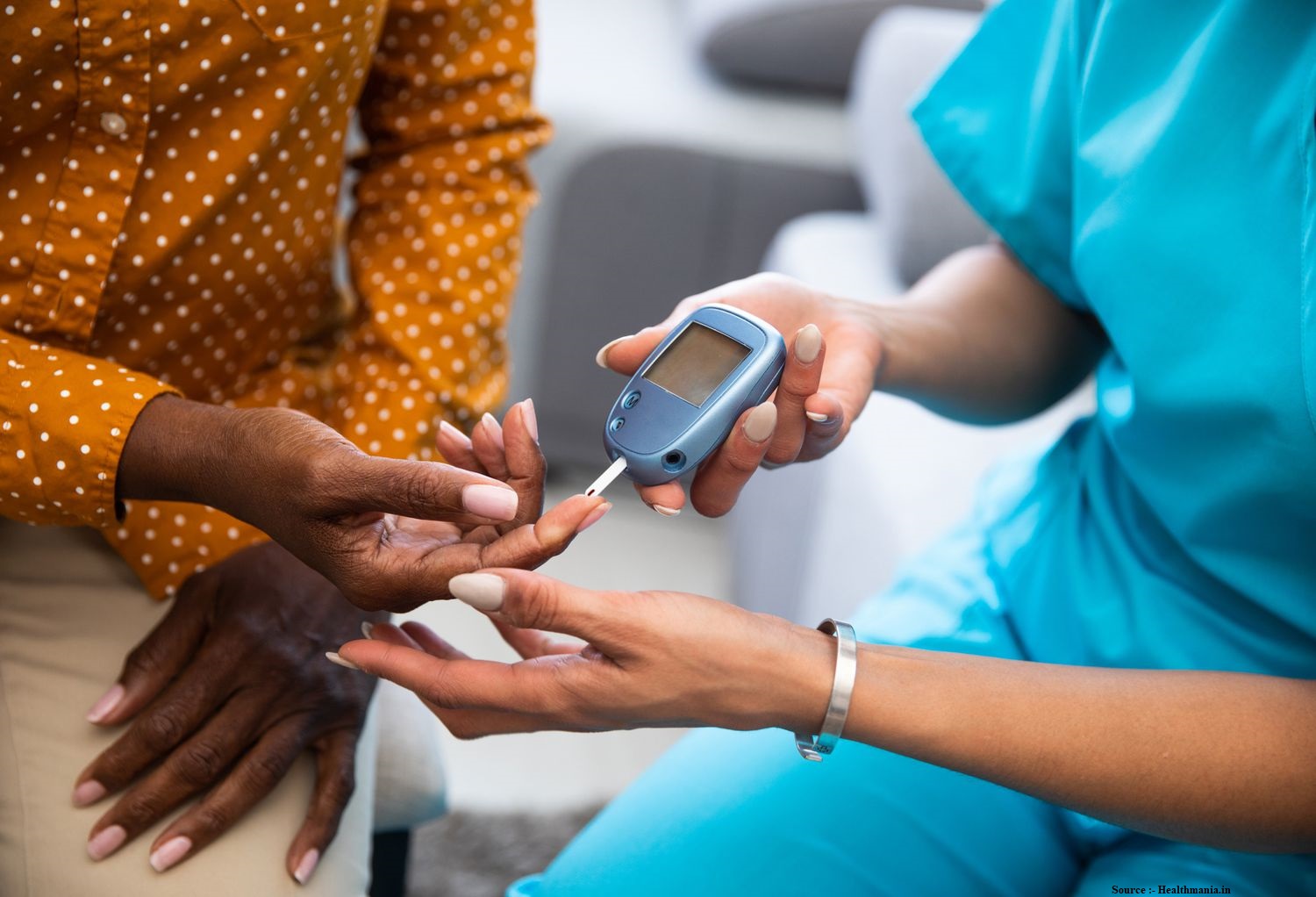

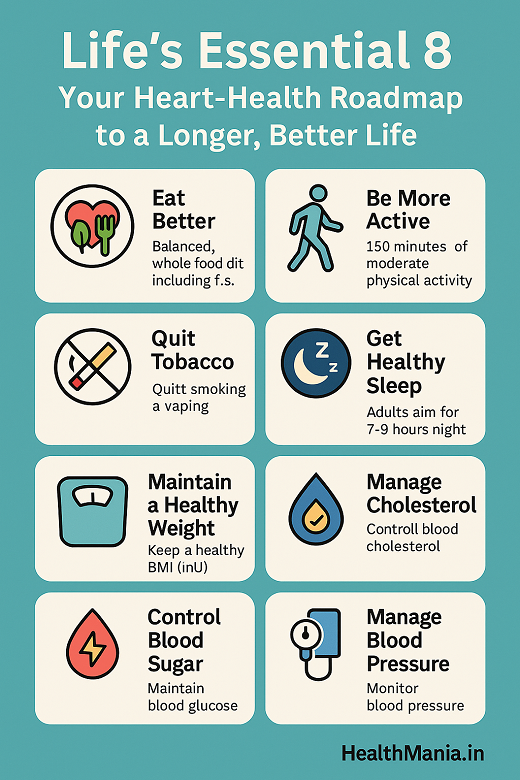

Superb article mam
thanks
Article is good but please use proper font.thanks.
thanks for your suggestion.